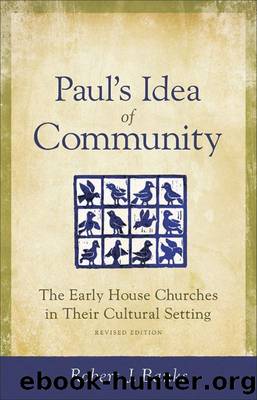Paul's Idea of Community: The Early House Churches in Their Cultural Setting, Revised Edition by Robert J. Banks

Author:Robert J. Banks [Banks, Robert J.]
Language: eng
Format: epub
Tags: Non-Fiction, Reference
ISBN: 9780801045547
Google: 31ZGngEACAAJ
Amazon: 0801045541
Barnesnoble: 0801045541
Goodreads: 10105211
Publisher: Baker Academic
Published: 1986-12-31T22:00:00+00:00
THE REDIRECTION OF RACE, CLASS,
AND GENDER DISTINCTIONS
This diversity can be demonstrated by considering ways in which the differences between each of these groups continued to play some part in the life of Paulâs communities.
Jews and Gentiles in the communities
Most of Paulâs communities contained a reasonable proportion of Jews. As long as Paulâs preaching in the cities began in the synagogue, this was bound to be the case, though God-fearers probably responded more freely to his message and formed the numerical base of his churches. In some places, such as Philippi, a Gentile Christian community seems to have existed from the start, but this was the exception.[18] Although, as we have seen, the Jews possessed no special advantage so far as acceptance into the Christian community was concerned, Paul can speak of their being favored over others by virtue of their role in Godâs program for humanityâs salvation.[19] In this respect Paul does not view the Christian community, with its predominantly Gentile membership, as altogether replacing Israel in Godâs purposes.
In the first place, Gentiles have only been âgrafted onâ to the Jewish olive tree (Rom 11:17). And though they have temporarily become the locus of Godâs saving work in the world, he still reserves a future role for Israel.[20] Even in the present, converted Jews play a prominent part in communicating the message of Christ, not only to other Jews but to non-Jews as well (Rom 1:1). All this lends weight to the suggestion that Jewish converts, because of their knowledge of the OT, had an important teaching function in the initial stages of church life.
More general differences also emerged between Jewish and Gentile Christians within Paulâs communities. Converted Jews and Gentiles tended to carry past religious and cultural patterns of behavior into their new way of life. Jews in particular, in the dispersion as well as in Jerusalem, continued to adhere to certain revered customs, such as observance of the Sabbath day and abstinence from particular kinds of food and drink. The distinction Paul draws between the âstrongâ and the âweakâ in Romans probably reflects this difference in lifestyle (chs. 14â15). There he distinguishes between âone who believes he may eat anythingâ and âesteems all days alikeâ and the other who âeats only vegetablesâ and âesteems one day as better than another.â This is not to say that some Jews did not break through to a freer attitude on such matters or that on occasions Gentiles did not maintain habits adopted from the synagogue. The distinction between âstrongâ and âweakâ does not in all respects correspond to that between âGentileâ and âJewishâ Christians, but there must have been a considerable overlap between the two.
Paul allows such cultural differences to coexist within his communities provided each person acts with integrity before God and does not put pressure upon others to conform (Rom 14:20â23). The âstrongââamong whom Paul counts himselfâhave to be particularly sensitive here (15:1). But when Jewish Christians turn what is a matter of lifestyle into a criterion of salvation
Download
This site does not store any files on its server. We only index and link to content provided by other sites. Please contact the content providers to delete copyright contents if any and email us, we'll remove relevant links or contents immediately.
Christian Ethics for a Digital Society by Kate Ott(724)
Fearfully and Wonderfully Made by Philip Yancey & Paul Brand(704)
The World from 1450 To 1700 by Wills John E.;(655)
God and the Multiverse by Victor J. Stenger(614)
Numbers by Ronald B. Allen(578)
How to Read Slowly by James W. Sire(560)
Christian Ethics: An Introduction to Biblical Moral Reasoning by Wayne Grudem(557)
Morality by Jonathan Sacks(511)
Monastic Archaeology by Unknown(494)
The Technological System by Jacques Ellul(482)
The Disabled Church by Rebecca F. Spurrier;(470)
Jesus: A New Vision by Whitley Strieber(467)
Amish Grace by Donald B. Kraybill & Nolt Steven M. & Weaver-Zercher David L(466)
Children of Lucifer; The Origins of Modern Religious Satanism by Ruben van Luijk(458)
Death of the Doctor by Unknown(451)
Critical Writings by Joyce James;(450)
Redeeming Sociology by Vern S. Poythress(440)
The City of God by Saint Augustine & Marcus Dods(438)
The Church in the Early Middle Ages by G.R. Evans(421)
